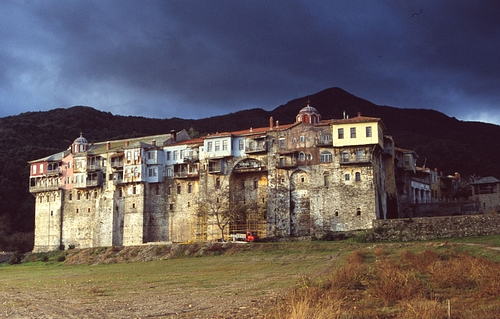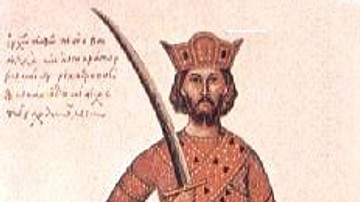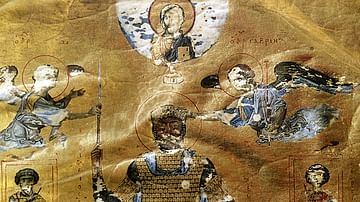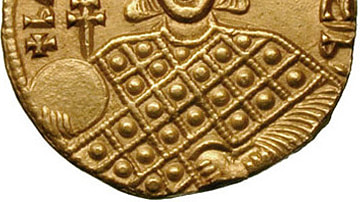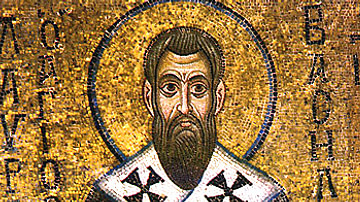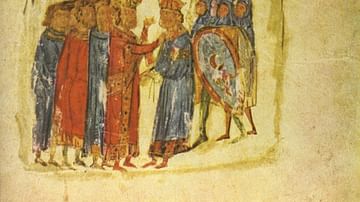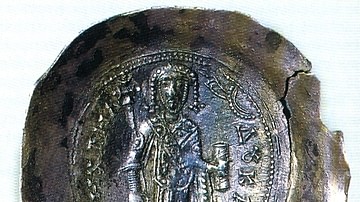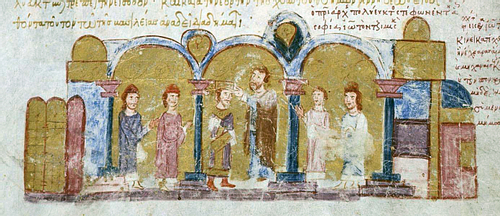
John I Tzimiskes was Byzantine emperor from 969 to 976 CE. Although he took the throne by murdering his predecessor Nikephoros II Phokas, John was a popular emperor. A skilled general and a competent politician, he is known for expanding Byzantium's borders to the Danube River in the west and further into Syria in the east.
Rise to Power
John was related to the landed military elite families of Byzantine Anatolia, including the powerful Phokas and Kourkouas families. He was married to a woman from the Skleros family, who died sometime before 969 CE. After John's uncle, Nikephoros Phokas, took command of the Byzantine armies in 955 CE, he gave a forward command appointment to John. John was described as a short but handsome general. He led multiple armies against the forces of Sayf al-Dawla (r. 945-967 CE), the powerful Emir of Aleppo, under Nikephoros' overall command. He was known for an aggressive style of command and, like Nikephoros himself, he was a highly successful general.
John was among the troops that proclaimed Nikephoros II Phokas (r. 963-969 CE) emperor in 963 CE. Nikephoros appointed John domestikos, or commander, of the East. John was one of the main commanders under Nikephoros in Cilicia and Syria, but after 965 CE Nikephoros distrusted him, stripped him of his titles, and placed him under house arrest.
On the night of December 10-11, 969 CE, John broke into the imperial palace with inside help and murdered Nikephoros with his co-conspirators. John immediately summoned Basil Lekapenos, the parakoimomenos, or director of the palace, to help secure John as the new emperor. By the morning, John had been crowned co-emperor with the young princes of the Macedonian Dynasty, the future Basil II (r. 976-1025 CE) and Constantine VIII (r. 1025-1028 CE). John prevented any looting from taking place following the coup, and other members of the Phokas family were placed under arrest and exiled. The fact that Nikephoros was already dead and that he was so unpopular allowed John to be accepted as emperor without any public outcry.
The Patriarch of Constantinople, Polyeuktos, agreed to crown John emperor in exchange for him canceling Nikephoros' decrees about the Church and blaming Empress Theophano, the mother of Basil and Constantine and widow of Romanos II (r. 959-963 CE) and Nikephoros, for instigating the murder of Nikephoros. It was even alleged that Theophano had had an affair with John before Nikephoros' murder. Theophano was then exiled by Basil the parakoimomenos. After being crowned, John married one of Romanos II's (r. 959-963 CE) sisters, Theodora, connecting him to the reigning Macedonian Dynasty.
Rebellion & European Wars
John promoted Bardas Skleros, the brother of his first wife, then deceased, to a high-ranking military position, which set off a rivalry between the Phokas and Skleros families. Meanwhile, John reversed Nikephoros' unpopular policies. Tzimiskes lowered taxes and ended the persecution of the Jacobite Syrian Church. Tzimiskes signed an order chartering Mt. Athos, the Orthodox monastic community in what is today northern Greece. He personally monitored the distribution of grain during a famine. He donated to religious and philanthropic institutions and made political compromises.
John also ended the war with the Holy Roman Empire in southern Italy. Peace in Italy allowed John to focus his attention on the more dangerous Rus problem left over from Nikephoros' reign. As part of the peace with Holy Roman Emperor Otto I (r. King of Germany 936-973 CE, Holy Roman Emperor 962-973 CE), John sent a relative, Theophano (also spelled Theophanu), to marry the future Otto II (r. 973-983 CE). Theophano would have a major role in transmitting Byzantine culture to Western Europe, including a burgeoning trade in ivory and silks from the Byzantine Empire.
Even with the Italian affair wrapped up, John was still faced with threats on two fronts, as the Rus loomed over Bulgaria in the north and the Fatimids were expanding into Syria following the demise of the Hamdanid Dynasty of the Muslim leader Sayf al-Dawla. At the same time, a group of officers, including the exiled relatives of the murdered Nikephoros II, Leo Phokas, and Nikephoros Phokas, tried to raise their other relative, Bardas Phokas, as emperor in a coup. The rebellion fell apart and was put down quickly.
Toward the end of his reign, Nikephoros II had invited the Rus into Bulgaria after relations with Bulgaria had turned sour. The Rus soldiers had effectively conquered most of the country by 971 CE, putting their powerful army just a few days away from Constantinople and posing a serious threat to the Byzantine Empire. John rounded up the army and marched north to the former Bulgarian capital of Preslav, which had been taken by the Rus. He captured the city and renamed it Iannoupolis (“City of John”). While John campaigned in Bulgaria, Leo and Nikephoros Phokas tried to launch a coup yet again, but they failed for the second time and were blinded.
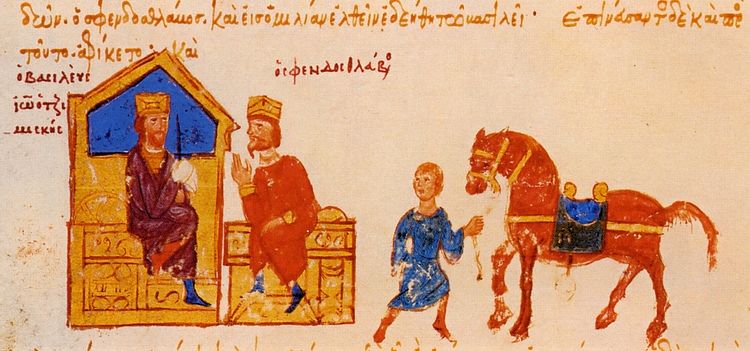
The Byzantine-Rus conflict came to a head at the Siege of Dorystolon in 971 CE, where John's forces crushed the Rus after a prolonged siege. Sviatoslav (r. 945-972 CE), the Rus leader, was forced to sue for peace and was killed by Pecheneg raiders during his retreat back to Kiev. John celebrated a triumph in Constantinople and divested the former Bulgarian Tsar Boris II (r. 969-971 CE) of his throne. Bulgaria was reannexed by the Byzantine Empire. Byzantium's borders extended to the Danube for the first time since 602 CE, and John built a series of border forts to prevent the Rus from invading again. In addition, the formerly autocephalous Bulgarian church was made subservient to the Patriarchate of Constantinople.
Campaigns in the East
With the Rus problem triumphantly solved, John turned his attention to the East. Although the death of Nikephoros II, the great “White Death of the Saracens,” could have left Byzantium's eastern provinces vulnerable, the Middle East was also in turmoil. The death of Sayf al-Dawla, the Emir of Aleppo, left a power vacuum. One of John's commanders took the city of Aleppo itself in early 970 CE, but in the Treaty of Safar, the Byzantines agreed to return Aleppo to the Muslims, although as a Byzantine client state. Aleppo lost a large swath of land to the Byzantines and was forced to pay an annual tribute.
While John's forces were triumphant against the remnants of the Hamdanid Dynasty, the powerful Fatimids decided to follow up on their conquest of Egypt by invading Syria. The Fatimids besieged Antioch for five months before being beaten back. An invasion of Egypt from Arabia forced the Fatimids to turn back, and while they would oppose the Byzantines in Syria in the years to come, they would never again be a serious threat.
Throughout his reign, John led a fearsome and large army into Syria repeatedly. In one of his campaigns, John supposedly had King Ashot III of Armenia (r. 952-977 CE) supply him with 10,000 Armenian soldiers to augment his army. In 972 CE, John invaded northern Mesopotamia, conquering the city of Nisibis and forcing the Emir of Mosul to pay tribute to the Byzantine Empire. However, the Byzantines faced a setback the next year when a Byzantine force under the commander Melias was defeated at Amida. John returned in force in 975 CE, making a grand tour of Syria. He sacked the city of Baalbek, received tribute from Damascus, conquered Byblos, received the submissions of Beirut and Sidon, and incorporated Laodikeia firmly inside the Byzantine Empire, all while ravaging the Syrian countryside. John had even come within striking distance of Jerusalem, but such a move would have drastically overextended Byzantine lines. John returned with a series of client states along the Byzantine border and a large wagon of captured treasures.
Death & Legacy
On his return to Constantinople, John fell ill and died on January 10-11, 976 CE. One story says that Basil Lekapenos poisoned John, but this was very likely simply slander against Basil.
John had come to the Byzantine throne by murdering his predecessor, but he was a good emperor. He was an accomplished military commander like Nikephoros II, and he defeated the threat of the Rus, conquered Bulgaria, and solidified Byzantine control in Syria. Unlike Nikephoros, John was also an astute politician and a popular emperor, in no small part due to his victory over the Rus and bringing large amounts of booty back to Constantinople. He and Nikephoros set the stage for Byzantine military resurgence and the height of medieval Byzantium under John's successor, Basil II.

